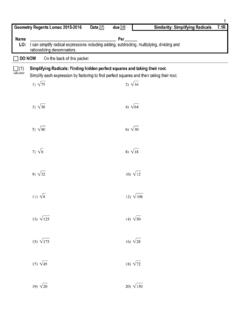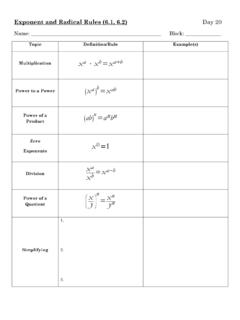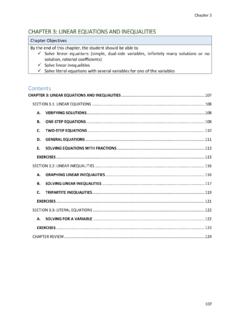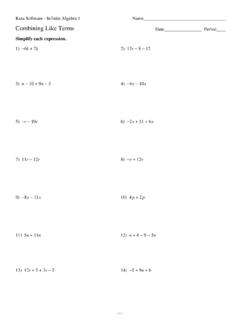Transcription of GCSE subject content and assessment objectives - GOV.UK
1 Mathematics GCSE subject content and assessment objectives 2 Contents Introduction 3 subject aims and learning outcomes 3 subject content 4 Scope of study 4 Number 4 Algebra 6 Ratio, proportion and rates of change 8 Geometry and measures 9 Probability 11 Statistics 11 Assesment objectives 13 Appendix: Mathematical formulae 14 3 Introduction GCSE subject criteria set out the knowledge, understanding, skills and assessment objectives common to all GCSE specifications in a given subject . They provide the framework within which awarding organisations create the detail of their specifications, so ensuring progression from key stage 3 national curriculum requirements and the possibilities for development into advanced-level study. subject aims and learning outcomes This document sets out the learning outcomes and content coverage required for GCSE specifications in mathematics.
2 In subjects such as mathematics, where topics are taught in progressively greater depth over the course of key stage 3 and key stage 4, GCSE outcomes may reflect or build upon subject content which is typically taught at key stage 3. There is no expectation that teaching of such content should be repeated during the GCSE course where it has already been taught effectively at an earlier stage. GCSE specifications in mathematics should provide a broad, coherent, satisfying and worthwhile course of study. They should encourage students to develop confidence in, and a positive attitude towards mathematics and to recognise the importance of mathematics in their own lives and to society. They should also provide a strong mathematical foundation for students who go on to study mathematics at a higher level post-16.
3 GCSE specifications in mathematics should enable students to: 1. develop fluent knowledge, skills and understanding of mathematical methods and concepts 2. acquire, select and apply mathematical techniques to solve problems 3. reason mathematically, make deductions and inferences and draw conclusions 4. comprehend, interpret and communicate mathematical information in a variety of forms appropriate to the information and context. Students should be aware that mathematics can be used to develop models of real situations and that these models may be more or less effective depending on how the situation has been simplified and the assumptions that have been made. Students should also be able to recall, select and apply mathematical formulae (see Appendix).
4 4 subject content GCSE specifications in mathematics should reflect the aims and learning outcomes outlined above, and should include the knowledge, understanding and skills listed below, giving due consideration to the assessment objectives . The essential subject content outlined here provides the framework for developing a coherent study at GCSE. This content sets out the full range of content for GCSE specifications in mathematics. Awarding organisations may, however, use any flexibility to increase depth, breadth or context within the specified topics or to consolidate teaching of the subject content . Students can be said to have confidence and competence with mathematical content when they can apply it flexibly to solve problems. The expectation is that: All students will develop confidence and competence with the content identified by standard type All students will be assessed on the content identified by the standard and the underlined type; more highly attaining students will develop confidence and competence with all of this content Only the more highly attaining students will be assessed on the content identified by bold type.
5 The highest attaining students will develop confidence and competence with the bold content . The distinction between standard, underlined and bold type applies to the content statements only, not to the assessment objectives or to the mathematical formulae in the appendix. Scope of study GCSE specifications in mathematics should require students to: Number Structure and calculation 1. order positive and negative integers, decimals and fractions; use the symbols =, , <, >, , 2. apply the four operations, including formal written methods, to integers, decimals and simple fractions (proper and improper), and mixed numbers all both positive and negative; understand and use place value ( when working with very large or very small numbers, and when calculating with decimals) 5 3.
6 Recognise and use relationships between operations, including inverse operations ( cancellation to simplify calculations and expressions; use conventional notation for priority of operations, including brackets, powers, roots and reciprocals 4. use the concepts and vocabulary of prime numbers, factors (divisors), multiples, common factors, common multiples, highest common factor, lowest common multiple, prime factorisation, including using product notation and the unique factorisation theorem 5. apply systematic listing strategies including use of the product rule for counting 6. use positive integer powers and associated real roots (square, cube and higher), recognise powers of 2, 3, 4, 5; estimate powers and roots of any given positive number 7.)
7 Calculate with roots, and with integer and fractional indices 8. calculate exactly with fractions, surds and multiples of ; simplify surd expressions involving squares ( 12= 4 3= 4 3=2 3) and rationalise denominators 9. calculate with and interpret standard form A x 10n, where 1 A < 10 and n is an integer. Fractions, decimals and percentages 10. work interchangeably with terminating decimals and their corresponding fractions (such as and 72or or 38 ); change recurring decimals into their corresponding fractions and vice versa 11. identify and work with fractions in ratio problems 12. interpret fractions and percentages as operators. Measures and accuracy 13. use standard units of mass, length, time, money and other measures (including standard compound measures) using decimal quantities where appropriate 14.
8 Estimate answers; check calculations using approximation and estimation, including answers obtained using technology 15. round numbers and measures to an appropriate degree of accuracy ( to a specified number of decimal places or significant figures); use inequality notation to specify simple error intervals due to truncation or rounding 16. apply and interpret limits of accuracy, including upper and lower bounds 6 Algebra Notation, vocabulary and manipulation 1. use and interpret algebraic notation, including: ab in place of a b 3y in place of y + y + y and 3 y a2 in place of a a, a3 in place of a a a, a2b in place of a a b abin place of a b coefficients written as fractions rather than as decimals brackets 2.
9 Substitute numerical values into formulae and expressions, including scientific formulae 3. understand and use the concepts and vocabulary of expressions, equations, formulae, identities inequalities, terms and factors 4. simplify and manipulate algebraic expressions ( including those involving surds and algebraic fractions) by: collecting like terms multiplying a single term over a bracket taking out common factors expanding products of two or more binomials factorising quadratic expressions of the form x2 + bx + c, including the difference of two squares; factorising quadratic expressions of the form 2axbxc++ simplifying expressions involving sums, products and powers, including the laws of indices 5. understand and use standard mathematical formulae; rearrange formulae to change the subject 6.
10 Know the difference between an equation and an identity; argue mathematically to show algebraic expressions are equivalent, and use algebra to support and construct arguments and proofs 7. where appropriate, interpret simple expressions as functions with inputs and outputs; interpret the reverse process as the inverse function ; interpret the succession of two functions as a composite function . Graphs 8. work with coordinates in all four quadrants 7 9. plot graphs of equations that correspond to straight-line graphs in the coordinate plane; use the form y = mx + c to identify parallel and perpendicular lines; find the equation of the line through two given points, or through one point with a given gradient 10. identify and interpret gradients and intercepts of linear functions graphically and algebraically 11.
















